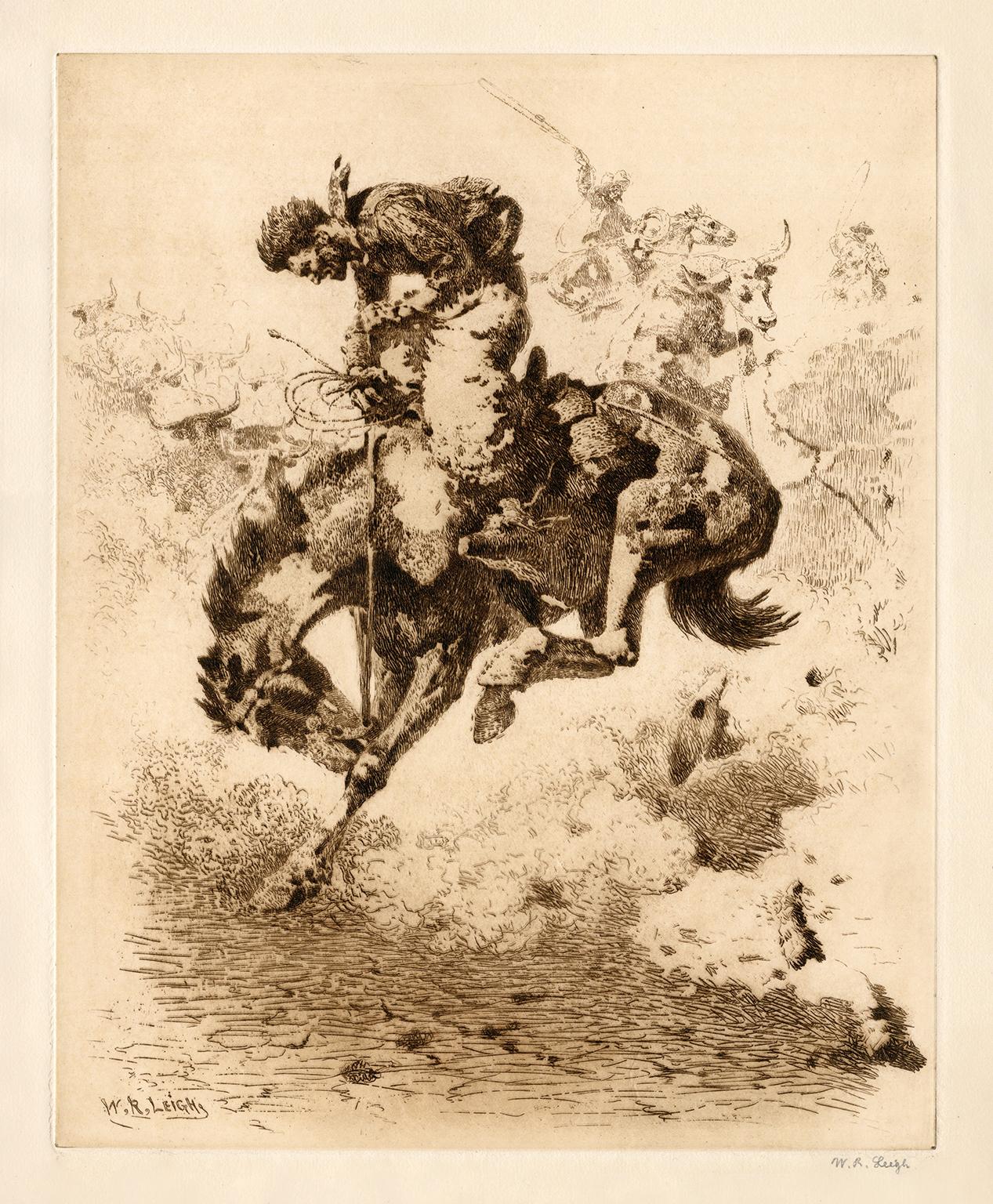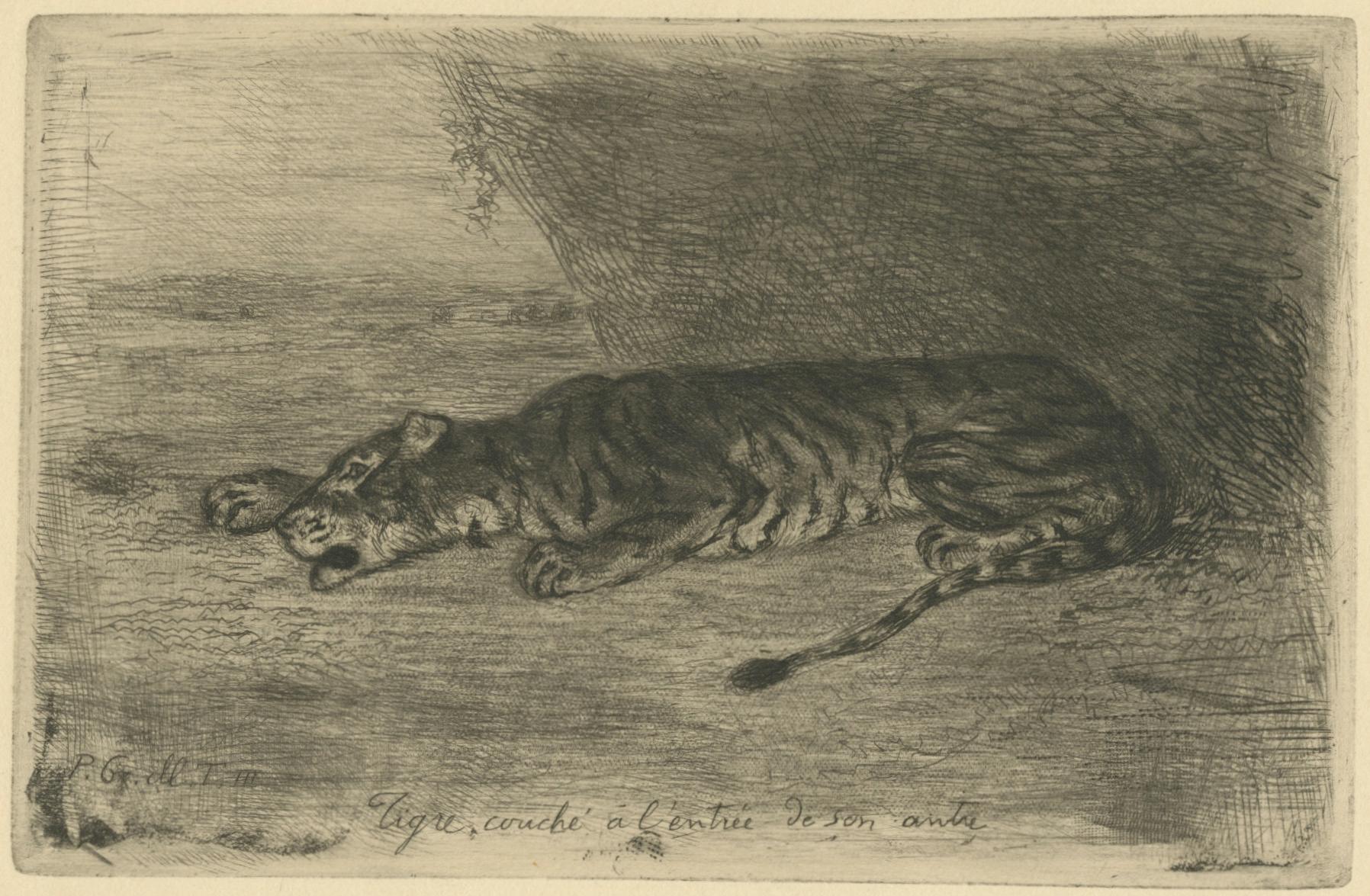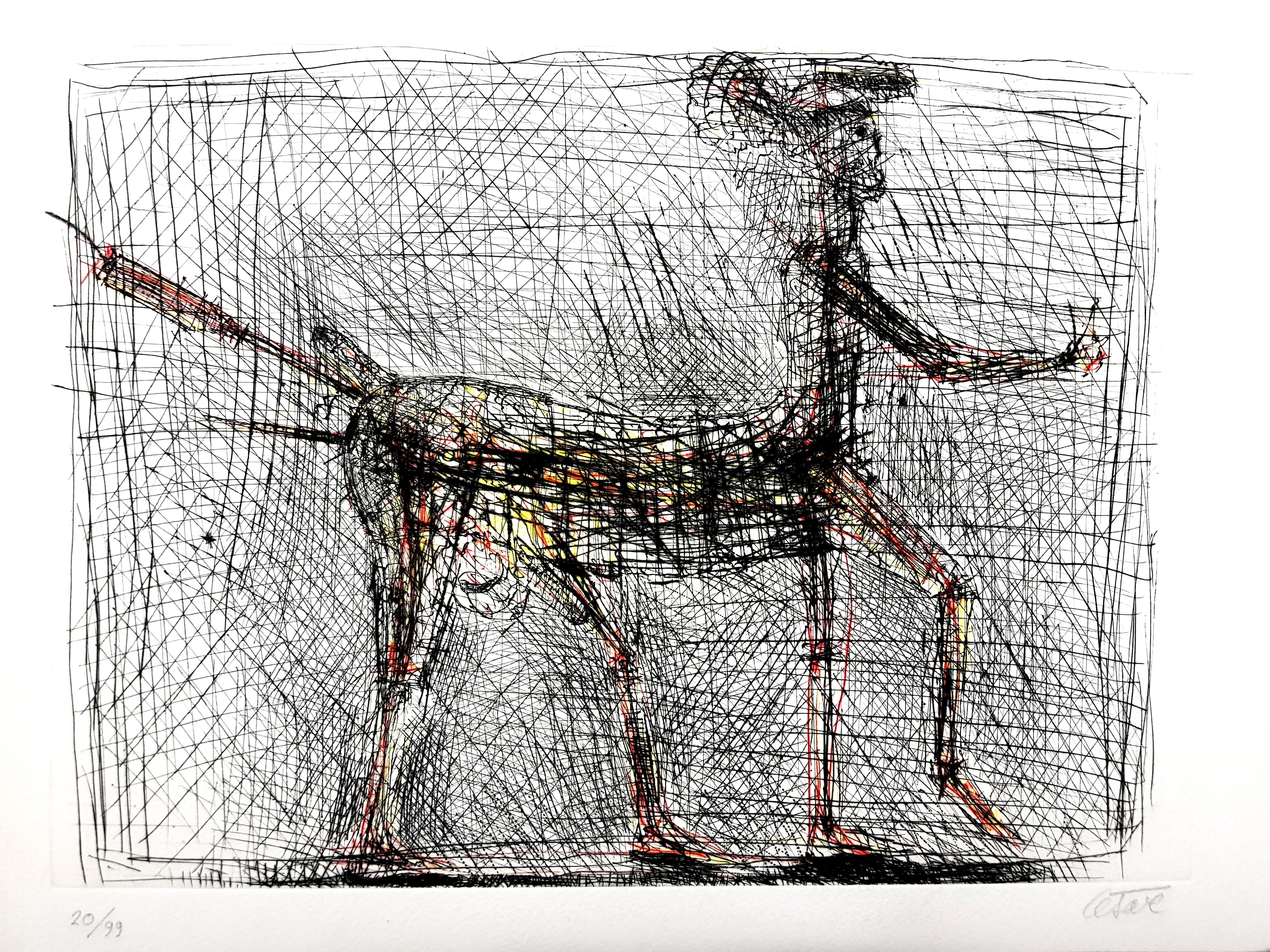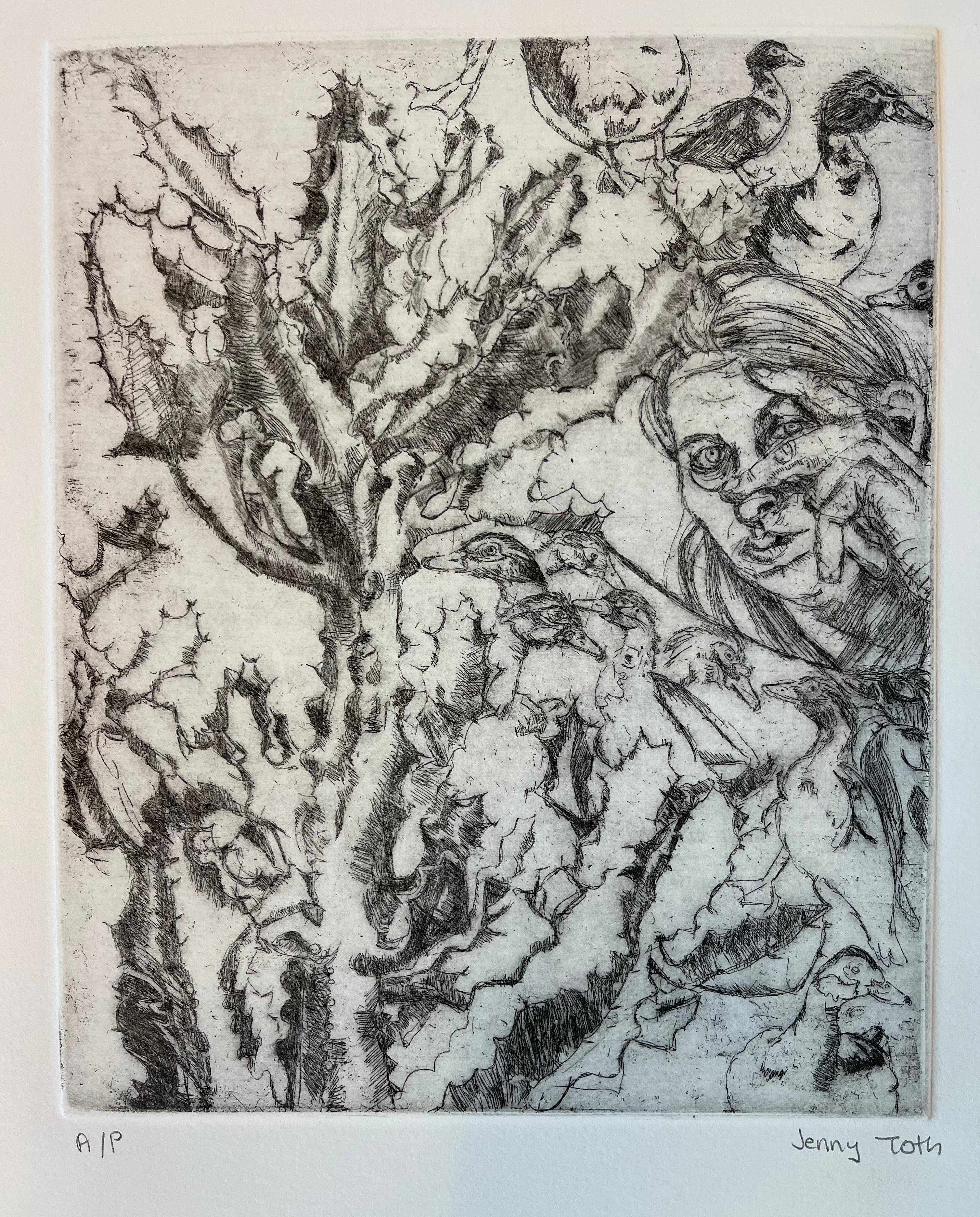Camille Pissarro"Vachere Au Bord de L'Eau, " Etching and Aquatint by Camille Pissarro1890
1890
About the Item
- Creator:Camille Pissarro (1831-1903, French)
- Creation Year:1890
- Dimensions:Height: 20.125 in (51.12 cm)Width: 17.625 in (44.77 cm)
- Medium:
- Movement & Style:
- Period:
- Condition:
- Gallery Location:Milwaukee, WI
- Reference Number:
Camille Pissarro
Camille Pissarro was one of the most influential members of the French Impressionist movement and the only artist to participate in all eight Impressionist exhibitions.
Born in July of 1830 on the island of Saint Thomas in the Danish West Indies, Camille was the son of Frédéric and Rachel Pissarro. At the age of 12, he went to school in Paris, where he displayed a penchant for drawing. He returned again to Paris in 1855, having convinced his parents to allow him to pursue a career as an artist rather than work in the family import/export business. Camille studied at the Académie Suisse alongside Claude Monet, and, during this time, he met Paul Cézanne, Édouard Manet and Pierre-Auguste Renoir.
In 1869, Camille settled in Louveciennes. The outbreak of the Franco-Prussian War in 1870 prompted him to move to England, and, with Monet, Camille painted a series of landscapes around Norwood and Crystal Palace, while studying English landscape painting in the museums. Upon returning a year later at the end of the War to Louveciennes, Camille discovered that only 40 of his 1,500 paintings — almost 20 years’ work — remained undamaged.
Camille settled in Pontoise in the summer of 1871, remaining there and gathering a close circle of friends around him for the next 10 years. He reestablished relationships with Cézanne, Manet, Monet, Renoir and Edgar Degas, expressing his desire to create an alternative to the Salon, so that their group could display their own unique styles. Camille married Julie Vellay, with whom he would have seven children. Cézanne repeatedly came to stay with them, and, under Camille’s influence, he learned to study nature more patiently, even copying one of Camille’s landscapes in order to learn his teacher’s technique.
The first Impressionist group exhibition, initiated by Monet in 1874, earned the Impressionists much criticism for their art. While mainly interested in landscape, Camille introduced people — generally, peasants going about their rural occupations — and animals into his works, and they often became the focal point of the composition. It was this unsentimental and realistic approach, with the complete absence of any pretense, which seemed to stop his work from finding appreciation in the general public.
One of the few collectors who did show interest in Camille’s work was a bank employee named Paul Gauguin, who, after acquiring a small collection of Impressionist works, turned to Camille for advice on becoming a painter himself. For several years, Gauguin closely followed his mentor, and, although their friendship was fraught with disagreement and misunderstandings, Gauguin still wrote shortly before Camille’s death in 1906: “He was one of my masters, and I do not deny him.”
In the 1880s, Camille moved from Pontoise to nearby Osny, before Eragny, a small village much further from Paris. At a time when he was dissatisfied with his work, in 1885, Camille met both Paul Signac and Georges Seurat. He was fascinated by their efforts to replace the intuitive perceptive approach of the Impressionists with a “Divisionist” method, or scientific study of nature’s phenomena based on optical laws. Despite having reached his mid-50s, Camille did not hesitate to follow the two young innovators. The following year, he passed on this new concept to Vincent Van Gogh, who had just arrived in Paris and was keen to learn of the most recent developments in art. However, after a few years, Camille felt restricted by Seurat’s theories and returned to his more spontaneous technique while retaining the lightness and purity of color acquired during his Divisionist phase.
In the last years of his life, Camille divided his time between Paris, Rouen, Le Havre and Eragny, painting several series of different aspects of these cities, with varying light and weather effects. Many of these paintings are considered among his best and make for an apt finale to his long and prodigious career.
When Camille Pissarro died in the autumn of 1903, he had finally started to gain public recognition. Today his work can be found in many of the most important museums and collections throughout the world.
Find original Camille Pissarro art on 1stDibs.
(Biography provided by Stern Pissarro Gallery)
- ShippingRetrieving quote...Ships From: Milwaukee, WI
- Return PolicyA return for this item may be initiated within 14 days of delivery.
- "Laboureur Du Kef (Plowman of Kef), " Original Lithograph by Alexandre LunoisBy Alexandre LunoisLocated in Milwaukee, WI"Laboureur du Kef (Plowman of Kef)" is an original lithograph by Alexandre Lunois. It features a figure plowing the field with a camel. The artist's name is lower left and the printe...Category
1890s Realist Figurative Prints
MaterialsLithograph
- "Combat Equestre, " Original Drypoint Etching signed by Claude WeisbuchBy Claude WeisbuchLocated in Milwaukee, WI"Combat Equestre" is an original lithograph by Claude Weisbuch. The artist signed the piece lower right and wrote the edition number (24/100) in the lower left. This piece depicts mu...Category
1970s Modern Figurative Prints
MaterialsEtching, Drypoint
- "Le Bouclier, " Original Drypoint Etching signed by Claude WeisbuchBy Claude WeisbuchLocated in Milwaukee, WI"Le Bouclier" is an original drypoint etching by Claude Weisbuch. The artist signed the piece lower right and wrote the edition number (25/100) in the lower left. This piece depicts ...Category
1970s Modern Figurative Prints
MaterialsEtching, Drypoint
- "Boy With Cows, " Original Drypoint Etching signed by John Edward CostiganBy John Edward CostiganLocated in Milwaukee, WI"Boy With Cows" is an original drypoint etching by John Edward Costigan. It depicts a young boy with three cows standing in a watering hole. The artist si...Category
1930s American Realist Figurative Prints
MaterialsEtching, Drypoint
- Affiche - Le Condottiere, signed inscribed to D.B.By Claude WeisbuchLocated in Milwaukee, WIArt: 29-3/8"x 21-1/8" Frame: 31'x 22-1/2" Original signed lithograph poster Claude Weisbuch was born in Thionville, France in 1927 and was a pupil at L' École des Beaux-Arts de Nanc...Category
1970s Animal Prints
MaterialsArchival Pigment
- "Présure Guillien, Dijon Cow, " Original Color Lithograph Poster by L. SerreLocated in Milwaukee, WI"Présure Guillien, Dijon Cow" is an original color lithograph poster. The artist's name is printed in the lower left, and the name of the printing company, Havas, is printed in the lower right. The poster advertises rennet, a product used to curdle milk and make cheese, featuring a milk maid with a red kerchief tied around her head in front of a white cow. She holds a golden bucket...Category
1920s Modern Figurative Prints
MaterialsLithograph
- Black GeeseBy Winifred AustenLocated in San Francisco, CAThis artwork titled "Black Geese" 1934 is an original color aquatint by noted British artist Winifred Marie Louise Austen, 1876-1964. It is hand signed and titled in pencil by the artist. The image (plate mark) is 9 x 13.75 inches, sheet size is 10.30 x 16.5 inches. Published by Arthur Greatorax LTD, Grafton street, London. It is in excellent condition. About the artist: Born at Ramsgate, Kent on 12 July 1876, Winifred Austen only daughter of Josiah Austin, a Cornish naval surgeon, and his wife Fanny, née Mann. She amended the spelling of her surname from Austin to Austen from the time that she began to exhibit. In 1892 the family moved to Hornsey, London from where Austin attended the London County Council School of Arts and Crafts, studying under Cuthbert Swan, an animal painter. I n 1899 Austen exhibited a picture of a lion at the Royal Academy and in all exhibited more than seventy pictures at the Academy, the last in 1961. She worked in both oils and watercolor but Austen is most highly regarded as an etcher. In all she made some two hundred etched plates, beginning in 1906 with a series entitled The White Heron. She had particular feeling for birds and small mammals, and the naturalist Sir Peter...Category
Mid-20th Century Realist Animal Prints
MaterialsAquatint
- 'Foul Rope (Left)' — early American rodeoBy William Robinson LeighLocated in Myrtle Beach, SCWilliam Robinson Leigh, 'Foul Rope (Left)', etching, c. 1920, edition unknown but small. Signed in pencil. Signed in the plate, lower left. A superb, richly-inked impression, in dark brown ink, on buff wove Umbria paper, the full sheet with margins (1 1/2 to 2 3/4 inches); slight toning at the sheet edges, otherwise in excellent condition. Very scarce. Image size 14 7/8 x 11 15/16 inches (378 x 303 mm); sheet size 20 3/8 x 15 3/8 inches (518 x 391 mm). Archivally matted to museum standards, unframed. ABOUT THE ARTIST Born near Falling Waters, West Virginia on a plantation a year after the Civil War, and raised in Baltimore, William Robinson Leigh (1866 - 1955) became one of the foremost painters of the American West. His career spanning some seventy-five years, Leigh created some of the most iconic depictions of the western landscape, admirers referring to him as ‘The Sagebrush Rembrandt’. The son of impoverished Southern aristocrats, Leigh took his first art training at age 14 from Hugh Newell at the Maryland Institute where he was regarded as the best student in his class. From 1883 to 1895, he studied in Europe, mainly at the Royal Academy in Munich with Ludwig Loefftz. From 1891 to 1896, he painted six cycloramas or murals in the round, a giant German panorama. In 1896, Leigh began working as a magazine illustrator in New York City for Scribner's and Collier's Weekly Magazine, and he also painted portraits, landscapes, and genre scenes. Leigh's trips to the Southwest began in 1906 when he made an agreement with William Simpson, Santa Fe Railway advertising manager, to paint the Grand Canyon in exchange for free transportation West. In 1907, he completed his Grand Canyon painting, which led to more commissions and an extensive painting trip through Arizona and New Mexico. These travels inspired him to paint western subjects for the next 50 years, his primary interest being the Hopi and Navajo Indians. In 1910, he traveled to Wyoming, where he painted in Yellowstone Park and created sketches, many of which he later converted into large canvases such as ‘Lower Falls of the Yellowstone’ (1915) and ‘Grand Canyon of the Yellowstone’ (1911). In 1926 he traveled to Africa at the invitation of Carl Akeley for the American Museum of Natural History, and from this experience wrote and illustrated 'Frontiers of Enchantment: An Artist's Adventures in Africa'. In 1933, he wrote and illustrated 'The Western Pony'. His adventures were chronicled in a number of popular magazines including Life, the Saturday Evening Post, and Colliers. For many years, his work was handled exclusively in New York by Grand Central Art Galleries at the Biltmore Hotel. In 1953 Leigh was elected into the National Academy of Design as an Associate member, becoming a full Academician in 1955. In March 1999, the Historical Center of Cody, Wyoming, held an exhibition of his field sketches and finished works depicting his experiences near Cody in the early part of the century. These years, between 1910 and 1921, when he often painted in the Carter Mountain vicinity, were considered pivotal to his artistic development and his devotion to the western landscape. Leigh's work is held in many museum collections of American western art...Category
1920s Realist Animal Prints
MaterialsEtching
- Tigre couché à l'entrée de son antre (Tiger Lying at the Entrance to its Lair)By Eugène DelacroixLocated in Middletown, NYEtching, drypoint, and roulette on watermarked Hallines cream laid paper, 3 3/4 x 5 7/8 inches (95 x 148 mm), full margins. A very good impression of this charming image, with all of...Category
Early 19th Century Realist Animal Prints
MaterialsDrypoint, Etching, Laid Paper
- César - Centaur - Picasso's Homage - Original Signed EtchingBy César BaldacciniLocated in Collonge Bellerive, Geneve, CHCésar Baldaccini Original Etching Dimensions: 56.5 x 40 cm Signed and Numbered Edition of 99 It is the only original etching ever made by César. César Baldaccini was born in Marseille in 1921. At the age of 12, he left the school to help his father, cooper. At 15 years old, he studied at the Art college of Marseille. He took evening drawing teachings, and then was interested in sculpture until 1939. In 1942, César received a scholarship and went to Paris. He studied ten years at the School of Beaux-Arts; he worked in the studios of Gaumont and Alfred Jeanniot and was named “Grand Massier” (teacher) of this school. At that time, he was living in the same house as Alberto Giacometti. In 1944, short of resources, he went to Marseille, then return to Paris, next year. With the 50s, he made discovered his work through his first exhibitions. One of its works (« The fish ») obtained a place in the Museum of Modern Art in Paris (1955). Henceforth, he exhibited ceaselessly, participating in numerous “Salons” in France and abroad. César received numerous prices there. He got personal exhibitions everywhere (Japan, the United States, Holland, France, Italy, etc.). Important retrospectives came, later. In 1970, he was named professor a foreman to the School of Beaux-Arts in Paris. During his all life, Caesar was stimulated by « the love of the profession » and by an extraordinary will to innovate. The humor of the man did not miss and was noticed through his work. Pablo Picasso was his major reference, also Alberto Giacometti, Germaine Richier, Pablo Gargallo and Julio Gonzales...Category
1980s Realist Animal Prints
MaterialsEtching
- Ducks Quacking, Cactus Peeking, linear style, monochromaticBy Jenny TothLocated in Brooklyn, NYThis is an artist proof aquatint of a woman peeking around a cactus with ducks mysteriously hovering in the upper right corner and a giant beautiful cactus overgrowing. The mood is ...Category
2010s Expressionist Figurative Prints
MaterialsPaper, Ink, Archival Ink, Aquatint
- Finger Parrot, monochromatic print bold graphic, surreal bird, handsBy Jenny TothLocated in Brooklyn, NYThis is an artist proof (one of a kind) aquatint of a parrot made up of fingers, and beautiful insects cascading to her right. She has a human ear on one side. The images is 6 x 6 ...Category
2010s Contemporary Figurative Prints
MaterialsPaper, Ink, Archival Ink, Aquatint





